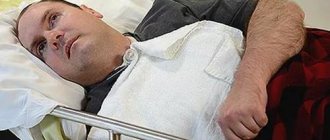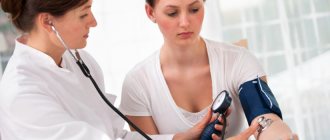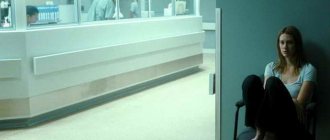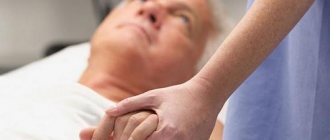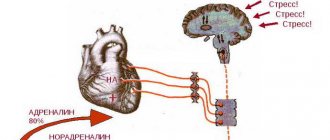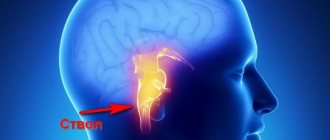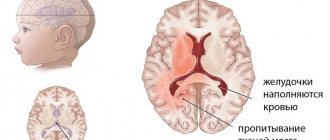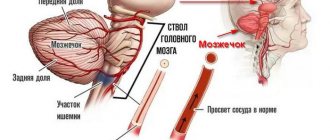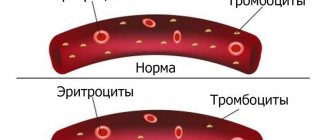About the disease
The essence of a cerebral stroke is a rapid disruption of its blood supply with the appearance of pronounced signs of neurological damage.
It occurs in the form of an attack, and occurs, most often, without obvious reasons.
Acute manifestations can persist for 15 hours or more, and failure to take emergency measures causes irreversible changes and death.
Depending on the mechanism of cerebrovascular accident, there are 2 main types of stroke:
- Ischemic type (cerebral infarction). It develops as a result of a complete or partial cessation of blood flow supplying brain tissue as a result of blockage of the lumen of blood vessels - blockage due to the formation of blood clots, cholesterol plaques, embolism or vascular stenosis. Poor blood supply can be caused by changes in blood composition (thickening). Typically, limited parts of the brain are affected by ischemic damage.
- Hemorrhagic type. Essentially, it is a hemorrhage in the brain tissue that occurs when a blood vessel ruptures. In this case, the blood is poured directly into the brain cavity. Such a stroke can be extensive and be much more severe.
Important! A small stroke (micro-stroke) is distinguished separately, when the anomaly develops gradually, and the process can last up to 15-20 days.
Therapy methods
Therapy for young people who have suffered apoplexy is aimed at minimizing damage to cerebral vessels, reducing the percentage of disability and the development of complications. The treatment regimen depends on the type of injury.
In case of ischemia of cerebral vessels, it is necessary to prevent the formation of blood clots or destroy existing ones. For this, the following groups of medications are used:
- blood thinners - Cyclopidine, Dipyridamole, Warfarin, Clopidogrel, Aspirin;
- to destroy a blood clot - tPA (Thromboplastin) intravenously;
- antihypertensive drugs - Enalapril, Captopril;
- vasodilators - Nitroglycerin;
- tranquilizers - Diazepam.
To prevent swelling of the meninges, Mannitol and Diacarb are used, pain is relieved with Morphine. If there is a threat of death due to a sharp increase in intracranial pressure, a hemicraniectomy is performed - an operation to open the skull.
Hemorrhage into the brain cavity often requires surgical intervention.
It is carried out using a minimally invasive technique, excluding the damaged area from the blood circulation. After normalization of the patient’s condition, nootropics and neuroprotectors are prescribed - Cerebrolysin, Actovegin, Cavinton, Phezam, Piracetam.
Causes
The etiology of stroke in young people is significantly different from the mechanisms of pathology in older people, in whom degenerative-dystrophic changes predominate.
Unfortunately, in most cases, the causes of pathology in young people remain unclear, which makes it difficult to exclude relapses, but general trends are visible.
The ischemic type is generated by the following most common causes:
- Thrombosis , provoked by atherosclerotic plaques and arterial embolism in the carotid and vertebral arteries;
- Narrowing , bending or compression of the main cephalic artery due to disturbances in the general circulatory system (low blood pressure, significant blood loss, abnormal heartbeat);
- Penetration of cardiac emboli formed in the chambers of the heart due to its defects or as a result of a violation of the valve system;
- Stenosis and blockage of small arteries with prolonged hypertension with pressure fluctuations;
- Deterioration of physico-chemical blood parameters , incl. DIC syndrome, dysglobulinemia and polycythemia
In young years, the following diseases can lead to cerebral infarction: diabetes mellitus, Vaquez disease, antiphospholipid type syndrome, hyperhomocysteinomia, migraine, arterial spasms.
The role of hereditary vascular pathologies is noticeable - Fabry disease, autosomal hypercholesterolemia.
Significant changes in blood composition are found in some infectious lesions (meningitis, enyephalitis, herpes). Compression of blood vessels is caused by benign and malignant tumors.
The main cause of hemorrhagic stroke is arterial hypertension. Somewhat less frequently, hemorrhages occur as a result of the destruction of saccular aneurysms (in particular, microaneurysms). There are also cases of stroke due to hemangioma, angiopathy of the amyloid variety, exposure to anticoagulants, alcohol and drugs, and traumatic brain injuries.
Hemorrhagic stroke
This type of pathology is less common than ischemic, but is also more dangerous, as it is accompanied by a violation of the integrity of the vessel. In this case, we are talking about a rupture with further hemorrhage in the brain cavities located on the outside. Even the rupture of one capillary can be enough to cause a hemorrhagic stroke. If a larger vessel is destroyed, the consequences will be much more dire and with a greater number of complications. The most likely outcome for a hemorrhagic stroke is death.
Who is at risk?
The group at increased risk of developing stroke includes young people with:
- cardiac, hemorrhagic and genetic diseases;
- leading an unhealthy lifestyle;
- exposed to frequent and severe stress;
- with poor nutrition.
Smoking, alcohol abuse, and drug addiction pose a particular danger. Dr. Ermolov’s clinic provides effective treatment for alcohol, drug, tobacco and other types of human addiction.
The likelihood of pathology also increases with uncontrolled use of medications, especially antibiotics, anticoagulants, antidepressants, etc. Young women taking hormonal oral contraceptives are at risk.
Consequences of stroke at a young age
Why is a stroke dangerous?
Such a severe pathology as a stroke can lead to serious consequences. What they will be depends on the timeliness of medical care provided to the victim.
Let's consider the consequences of a stroke in a woman at a young age.
Girls aged 20-30 recover faster and are less susceptible to strokes. But if there is no help in the first hours after an attack, you may encounter a number of consequences:
- decreased visual acuity;
- temporary or partial memory loss;
- paralysis of one part of the body;
- convulsions;
- loss of sensation;
- hearing loss.
Impaired motor activity can be overcome during the rehabilitation period, although loss of coordination of movements can be observed for another six months after the stroke.
Symptoms of pathology
If in childhood strokes are more common in boys than in girls, then starting from adolescence, girls suffer much more often. It should be noted that the symptoms of the pathology in young girls are more pronounced than in boys, and the attack is more acute and severe.
The following main signs of stroke in young people of both sexes are identified:
- Intense headache of a sharp nature and dizziness, even to the point of fainting.
- Vision problems, incl. loss of clarity of vision in one eye (less commonly, the symptom spreads to both eyes).
- Violations of the vestibular system (balance in a standing position, lack of coordination, etc.).
- Nausea, and sometimes vomiting, which does not bring relief, causeless hiccups.
- Dissociative motor disorder.
- Convulsive twitching and muscle weakness (spasms) of the upper and lower extremities.
- Feeling of tinnitus.
- Numbness of the facial muscles on one half, lasting for a short time.
- Irregular heart rhythm with tingling in the heart area.
- Incoherence of speech.
- General weakness, loss of sleep.
In women, additional symptoms may appear: pain in the chest, shortness of breath, spatial disorientation.
Most often, stroke in young people occurs without loss of consciousness, and therefore the symptoms cause a feeling of strong fear for life.
In general, it is quite difficult to differentiate stroke from other pathologies at a young age due to the slower development of the process and the similarity of some symptoms.
In particular, it can be confused with a heart attack or hypertensive crisis.
Quite often, a harbinger of a stroke is a microstroke, the symptoms of which can disappear quite quickly, making diagnosis difficult. The following signs are noted:
- asymmetry of the lips when trying to smile, as well as a shift of the tongue to the side;
- the emergence of difficulty in linking words when pronouncing a sentence;
- The difficulty is in maximally raising the outstretched arms.
Detection of pathology at the stage of a microstroke helps to take timely measures to eliminate more severe brain damage.
Such signs are typical both for teenagers of 15 years old and for people at a more mature age - at 20, 25, 30 years old.
Prevention
In order to prevent stroke at a young age, doctors recommend that young people carefully monitor their health. Any unfavorable symptoms should not be attributed to fatigue, but should be perceived as the first alarm bells. Especially if the young person has any chronic diseases. It is extremely important to have an annual preventative medical examination. The key to normal functioning of the whole body is a healthy lifestyle. In particular, optimal physical activity, proper nutrition, and abstinence from alcohol, smoking and any drugs are indicated. It is also very important to rationally organize periods of work and rest.
The prognosis for young people who have had a stroke is somewhat more favorable than for older patients. However, it all depends on the area of the brain affected and its size. In general, the mortality rate among young patients with stroke is 40–50%. Moreover, most often, death does not occur immediately during the attack, but later against the background of formed cerebral edema. The percentage of total or partial disability among young people with a history of stroke is approximately 60–65%. Complications can range from complete paralysis to partial impairment of the basic functions of the sensory organs or limbs. This is why it is so important to promptly seek medical help if even mild signs of a stroke appear. Remember, your life depends only on yourself.
How to treat?
Stroke in a young person is most often treated with conservative methods.
Surgery is performed only in cases of extensive hemorrhage and a high risk of death.
First aid plays an important role in healing.
If signs of a stroke appear, you should urgently call an ambulance, but you should take independent steps before it arrives.
The victim must be fenced off from any emotional stress and placed on a hard, horizontal surface with his head raised. To ensure the supply of oxygen, fresh air is provided and the body is freed from constricting clothing. If your doctor has previously prescribed medications for hypertension, you can use them to try to lower your blood pressure.
Hospitalization of the victim is mandatory. To make an accurate diagnosis, the necessary studies are carried out:
- general and biochemical blood test;
- Ultrasound of the brain, great and cranial vessels;
- MRI or computed tomography;
- Agniography using X-ray contrast method;
- ECG and EchoCG.
Drug therapy includes the following measures:
- Reducing blood pressure - intramuscular injection of Aminazin, Anaprilin, Dibazol together with Papaverine.
- Stabilization of myocardial function – Cordiamin, Celanide.
- Normalization of blood circulation in the brain - Actovegin, Cavinton, nicotinic acid.
- Elimination of blood microcirculation disorders - Fraxiparine, Pentoxifyline.
- Neuronal protection – glutamate antagonists (magnesium drugs), postsynaptic glutamate inhibitors, calcium channel blockers, nootropic and antioxidant agents.
In addition to medications, therapeutic massage and special exercise therapy are provided. The treatment regimen is exclusively individual in nature.
First aid for stroke
Stroke is a serious pathological process that can lead to many complications and consequences, which will depend on the quality and timeliness of medical care. To stop the attack, the patient is given special medications. Before the doctors arrive, you need to help the patient yourself.
During a stroke, a person must be placed horizontally so that his legs are higher than his head. You should put a pillow under your head. If the patient is wearing tight clothes, they need to be removed or the buttons undone, and the tie should be loosened if there is one. The window in the room where the patient is located must be opened, which will provide fresh air, and the curtains, on the contrary, must be closed. The patient must be ensured peace and tranquility until the doctors arrive.
Quite often, a person with a stroke is overtaken by a state of panic and a feeling of fear. In this case, you need to try to calm the patient and lay him horizontally.
Recovery and rehabilitation
Recovery and rehabilitation of injured young people after a stroke differs little from similar activities for older patients.
Young people go through this stage faster and are more receptive to modern techniques, which increases their effectiveness.
The specific regimen depends on the degree of functional damage and is aimed at preventing relapses.
Rehabilitation begins in the hospital, but final recovery is achieved at home. The duration of their implementation can range from 2-3 months to 1-2 years.
Recovery after a stroke proceeds in the following directions:
- Normalization of motor functions includes measures against paralysis and restoration of walking skills, necessary movements, and performance. Massage, exercise therapy, kinesiotherapy, physiotherapy and ergotherapy are used;
- Restoring memory and speech abilities . It is necessary to involve a speech therapist, preferably with an emphasis on aphasiology;
- Normalization of the functions of the pelvic organs , in particular the urination system, eliminating problems with bowel movements. The genitourinary system and intestines are restored with the help of medications and physiotherapy as prescribed by a rehabilitation physician;
- Psychological rehabilitation . It is most effective with the participation of an experienced psychologist.
In general, the recovery of the victim largely depends on the attitude of loved ones and the regularity of the necessary activities. Assistance in post-stroke recovery can be obtained in special rehabilitation centers.
Features of rehabilitation
For young patients who have suffered a stroke, it is very important to undergo timely rehabilitation. With all prescribed medications, it is recommended to do the following:
- Massage of limbs that have lost sensation. It begins on day 2 after an ischemic attack and on days 5–6 after a hemorrhagic one. Systematicity and perseverance are important. Massage restores blood flow in the extremities and improves metabolic processes in tissues. You should always start the massage from the healthy side of the body in order to send impulses about the movement of the limbs to the brain.
- Gymnastics. Indicated for developing joints of limbs that have lost sensitivity and for increasing muscle tone. Initially, it is advisable to carry out with the help of a specialist.
- Physiotherapeutic procedures as prescribed by the attending physician. Electrophoresis and other similar manipulations activate the functioning of nerve endings, due to which the limbs quickly receive impulses from the brain and send them back.
- Working with a speech therapist for speech loss. Restoring speech activity is important for further full social life.
- Restore memory if necessary. Here a neuropsychologist and occupational therapist are involved in the work.
- Restoring the functioning of the eyelids. Special gymnastics is required under the supervision of an ophthalmologist, kinesiotherapist and physiotherapist.
- Taking drug therapy to stimulate higher nervous activity.
Important: vision lost after a stroke cannot be restored.
Possible consequences
Post-stroke consequences depend on the extent and location of the lesion, as well as the effectiveness of treatment.
If help is not given in a timely manner, the following complications may occur:
- paralysis of limbs;
- mental disorders;
- ophthalmological problems;
- urinary disturbance;
- communication problems;
- mental retardation.
For young people, rehabilitation measures with the involvement of a speech therapist, psychologist, or physiotherapist most often help eliminate negative consequences within 7-12 months.
Useful video on the topic:
Causes of stroke in people aged 30 years
Stroke in young people is more often diagnosed as ischemic (more than 50% of cases). That is, there is a sudden disruption of blood flow in the vascular system of the brain. In turn, a violation of the blood supply occurs against the background of blockage of the vessel by a thrombus or against the background of its spasm. The immediate causes of stroke in young men and women, which lead to the separation of a blood clot or artery spasm, are:
- diabetes mellitus type 1, in which angiopathy develops;
- unclosed oval window;
- aortic aneurysm of the interatrial septum.
In other cases, young people are diagnosed with a hemorrhagic type of stroke. That is, a cerebral hemorrhage occurs. Pathology is formed for a number of reasons:
- smoking and frequent drinking of alcohol;
- drug addiction and substance abuse;
- love for fatty foods, sweets and fast food;
- obesity;
- taking oral contraceptives;
- constant stress and emotional stress;
- constant disruption to the daily routine (night shifts, shift work without proper rest).
Among the less common causes of stroke in young people are the following congenital and acquired pathologies:
- mitral valve prolapse;
- tumor in the area of the skull and neck;
- myxoma of the heart;
- blood diseases such as leukemia, anemia, etc.;
- vasculitis;
- taking anticoagulants;
- protein deposition.
Prognosis for recovery and life
The prognosis for survival in young patients with timely treatment is quite favorable; moreover, it is possible to maintain a normal quality of life during ischemic stroke.
Mortality during a severe ischemic attack among victims under the age of 40 does not exceed 2-4%. When effective rehabilitation is provided, motor and speech abilities are restored in almost 70% of patients. More than half of all victims return to a full life.
Relapses occur in 1.5-2% of young people. The picture is somewhat worse for hemorrhagic stroke. The mortality rate can reach 7-8%. 55-60% remain disabled for life.
Features of treatment
When a girl or young man is admitted to a hospital with a diagnosis of stroke, doctors initially take measures to maintain basic vital signs. In rehabilitation conditions, the following therapy is carried out:
- artificial ventilation to maintain breathing capacity;
- normalization of blood pressure and constant control over it;
- restoration of normal electrolyte composition of the blood.
The following medications are prescribed:
- Aminocaproic acid or "Dicinone". Stop bleeding.
- "Glycine", "Thiotriazoline" or "Somazina". They are neuroprotectors and actively stop the death of brain cells.
- "Metindol" or "Olfen". Relieves fever.
- "Cerucal" or "Metoclopramide". Stop vomiting.
- Magnesia intravenously or Haloperidol. Neutralizes excitement.
- "Prednisolone", "Mannitol". Relieves cerebral edema.
- Lorazepam or Thiopental are used as anticonvulsants.
Hemorrhagic stroke is treated only surgically by removing the resulting hematoma and pumping out the blood that has spilled into the brain space.
Important: during treatment and rehabilitation of the patient, his head and shoulders should be raised relative to the horizontal by approximately 30 degrees.
Features of prevention
The following preventive measures can help minimize the risk of stroke in young adulthood:
- Proper nutrition. Harm is caused by products with dyes and chemical additives, smoking and confectionery products. Food should contain a moderate amount of fat;
- Elimination of bad habits , given that even low-alcohol drinks increase the risk of hemorrhage;
- Limiting the use of hormonal-type oral contraceptives
- Constant stress should be avoided. Frequent lack of sleep can provoke pathology;
- If headaches of an unknown nature occur, you should undergo periodic tomography (at least 2 times a year);
- Potent medications should be taken only as prescribed by a doctor.
Timely treatment of various diseases, optimization of the daily routine, combination of an active lifestyle with good rest virtually eliminates early brain damage.
Stroke is a serious pathology that can cause serious consequences. You should not think that youth is a protection against this scourge. The advice of experts is quite simple: giving up smoking and alcohol, playing sports, and optimal nutrition are what will help you avoid illness. If alarming symptoms appear, you should immediately consult a doctor.
Risk factors for stroke in young people
Genetics
A meta-analysis of twelve studies involving almost 60 thousand people found that there are four genes that influence susceptibility to apoplexy. In simple terms, if your parents (or grandparents) suffered an attack, then you should monitor your health very carefully.
Pathologies, anomalies and diseases of the heart and blood vessels
People with heart problems (ischemia, atrial fibrillation, valve pathologies) and developmental anomalies of this organ must monitor their condition and undergo regular examinations.
Diseases of the veins and arteries are also risk factors, but if you or your loved ones have already been diagnosed with them, it is important to monitor the quality and quantity of food, include physical activity in your regimen and regularly visit specialists to prevent complications.
Gender is a risk factor
In old age, the risk factor is male gender, but at a young age women are at risk, especially those taking hormonal drugs and smoking. The fact is that these two factors affect blood clotting - they increase it and, accordingly, can cause an ischemic stroke.
Women who have recently given birth are also at risk. Pregnancy and childbirth are very difficult processes, and often the body increases blood clotting (especially after childbirth) to avoid large blood loss. This causes thrombosis.
Metabolic disorders
A wide range of metabolic problems lead to the development of strokes at any age. Sad statistics show that currently a very large number of elderly people suffer from metabolic syndrome and type 2 diabetes. These conditions negatively affect the condition of blood vessels.
A problem with metabolism is a problem of reducing the overall quality of life: physical inactivity, imbalance of dietary fat, polyhypovitaminosis. And this is a factor that we can influence, for example, giving up bad habits, improving nutrition, moving more. We hear all this advice regularly, but few people fully understand their importance.
Emotional factor
Many diseases are attributed to stress. And for good reason. The first danger of chronic nervous tension (and lack of sleep) is a change in the level of cortisol, which “pulls” other hormones with it. Constantly being “on your nerves” is a direct route to a neurologist. High blood pressure, headaches, chronic fatigue syndrome, constant overload - these are the terrible realities of the modern world.
Controlling emotions and lifestyle are factors that we can also influence. But, unfortunately, they are rarely paid attention to in the pursuit of success and career growth. It’s even sadder that even after the attack has already happened, young people continue to live the same way, which should not be allowed at all.
Treatment
When you notice symptoms of a stroke in yourself or a loved one, call paramedics immediately. It is necessary to ensure complete immobility of the victim. The head should be 30 degrees higher than the body. Drinks and food cannot be given. Treatment of the disease is as follows:
- taking medications improves blood supply to the brain;
- physiotherapy;
- classes with a speech therapist to restore speech function;
- exercise therapy;
- occupational therapy.
A treatment plan is developed individually for each victim. Recommendations for normalizing body weight are considered general. It is also necessary to take a hormone test. Often, increased cholesterol production and weight gain are associated with problems with the thyroid gland.
Basic rules that must be followed
To prevent this from happening, doctors recommend the following preventive measures:
- Balanced diet. Eating enough greens, fruits and vegetables, meat and poultry. Sugar, carcinogens and large amounts of fat should be excluded from the diet.
- Physical exercise. To keep your heart in good condition, 3-4 exercise sessions per week are enough.
- Stressful situations. They should be avoided whenever possible.
- Drinking alcoholic beverages. We are talking about limiting the amount of alcohol consumed.
It is important to be attentive to your health even at a young age. You need to undergo regular medical examinations.
We looked at the main causes of cerebral stroke at a young age.
Disease prevention
Regardless of age, lead a healthy lifestyle, exercise regularly, monitor your blood pressure and undergo preventive diagnostics once a year.
If you notice that blood pressure abnormalities are happening more and more often, you should see a doctor. He will conduct tests, adjust your training regimen and prescribe medications. There are often cases when such examinations helped to diagnose irregular contractions of the heart muscle or atrial fibrillation in the early stages. Without treatment, these pathologies will eventually lead to a stroke.
To reduce the likelihood of a stroke, as early as 20 years of age, you need to monitor your health:
- If your blood viscosity is high, do not use pharmaceuticals containing estrogen (this also includes oral contraceptives). It is useful to give up cigarettes, fatty foods and alcohol.
- Treat migraine at the first symptoms. This disease is more common in women over 25 years of age. If a patient develops visual hallucinations during headaches, this indicates a migraine infarction.
- At the first signs of vascular atherosclerosis, undergo a full diagnosis. Based on the tests, the specialist will select a diet and prescribe medications.
- Treat neurological disorders with the utmost severity, for example: numbness of the limbs, visual hallucinations, mental inhibition, problematic speech, etc. These signs are bad for your health, and even a rare occurrence signals the likelihood of a stroke.
It is important to understand that stroke is a real threat to human health, and very often it is the cause of the premature death of a young patient. Therefore, doctors ask you to listen to the recommendations and protect your health.
Hit on the sly
Volleyball player Natalya Safronova suffered a stroke at the age of 30.
Photo by Reuters
“Kondrash has had enough” - this used to happen to people in their old age. Now, more and more often, stroke affects people in their prime. 40-year-old billionaire Viktor Bortsov just died from a stroke; a year ago, volleyball player Natalya Safronova suffered a stroke, thank God, she survived. NG columnist Ada GORBACHEVA asked the head of the cardioneurology laboratory of the Scientific Center of Neurology of the Russian Academy of Medical Sciences, Professor Andrei FONYAKIN, about the causes of vascular accident in young people.
– Andrey Viktorovich, it has always been believed that stroke is a problem of old age. Now and then we hear about strokes in people in the prime of life. Maybe it’s just that each such case makes a special impression?
– In translation, stroke means blow. First described in 1599, sudden brain injury was called "the stroke of God's hand," according to the Oxford Dictionary. The most common cause of stroke is a blood clot blocking an artery supplying blood to the brain (ischemic stroke) or bleeding from a damaged cerebral artery (hemorrhagic stroke).
Indeed, there is a trend towards younger strokes. According to various studies, the incidence of ischemic stroke in young people ranges from 2.5 to 13% of all cases of cerebrovascular accidents. The lethal outcome and disability of people of socially active age give the problem a special drama.
– Why does stroke occur in young people?
– The main causes of stroke include blockage of an artery by a thrombus or embolus, or rupture of a cerebral artery aneurysm. However, risk factors, that is, characteristics of the body or external influences that lead to an increase in the risk of the disease, are quite numerous. At a young age, congenital abnormalities play an independent role, such as a hereditary increase in blood clotting and a tendency to thrombus formation, connective tissue dysplasia, vascular and cardiac anomalies.
On the other hand, already at a young age, diseases characteristic of older people can develop: atherosclerosis, arterial hypertension, acquired heart defects, coronary heart disease, atrial fibrillation. However, not all congenital or acquired disorders necessarily result in brain complications. Therefore, it cannot be said that every pathology is fatal, although under certain conditions it can suddenly manifest itself as a brain catastrophe.
– Is a stroke really always sudden?
– For a long time, a stroke was perceived as an inevitable misfortune, but in recent decades it has become clear that a lot depends on the person, on his attitude towards himself. There are a number of modifiable risk factors for stroke, and this mainly concerns a modern lifestyle with many bad habits and neglect of one’s health.
One of the most aggressive and harmful human addictions is smoking. It has been established that the smoke of one puff of a cigarette contains approximately 10 to the power of 15 free radicals and about 4,700 different chemical compounds. The sizes of individual particles are less than one micron. They freely penetrate the respiratory tract, damage capillaries, which leads to increased stiffness of the arteries, increased blood clotting, and the rapid development and progression of atherosclerosis. For both men and women under 55 years of age, smoking is the leading risk factor for stroke.
Another risk factor is arterial hypertension, which causes accelerated development of atherosclerosis and changes in the heart and cerebral arteries. Over time, this leads to deterioration of cerebral circulation, the appearance of coronary complications and atrial fibrillation. Increased body weight also contributes to a rise in blood pressure.
Another risk factor is alcohol abuse, which is accompanied by an additional increase in blood pressure, the development of cardiomyopathy and heart rhythm disturbances. Drinking large doses of alcohol is especially dangerous. There is even a concept of “weekend stroke”, when during non-working days the incidence of stroke increases among young and active people who spend time in nightclubs, sharply increasing the number of cigarettes smoked and alcohol consumed.
Leo Tolstoy wrote: “The demands of people who smoke, drink, overeat, do not work and turn night into day that the doctor should make them healthy are ridiculous.” In other words, the sudden development of neurological symptoms is not always sudden; it is preceded by all kinds of negative stress on the cardiovascular system.
– What should be done to prevent stroke, especially for young people who most often consider themselves healthy a priori?
– One of the features of congenital and a number of acquired diseases at a young age is the absence of specific symptoms and ignoring unpleasant sensations. Therefore, it is very important to take good care of yourself, especially if close relatives have had a stroke.
It is necessary to stop smoking. Quitting smoking after six months reduces the risk of stroke by 50%. You need to limit your alcohol consumption. According to the latest recommendations, occasional drinking of alcohol in moderate doses is allowed (no more than two glasses of wine per day or 50 ml of spirits). Drinking every day is a bad and dangerous habit. And at a young age, you should monitor your blood pressure and, if it turns out to be elevated, consult a doctor, even if nothing is bothering you. Normalizing blood pressure reduces the risk of stroke by 40% within the first year of treatment. You need to eat less fatty foods, control your weight and move more. Regular physical activity helps lower blood pressure and normalizes fat levels in the blood. Nothing new, all these recommendations are well known, but, unfortunately, few people follow them.
“However, strokes also occur in young people who do not drink or smoke, although they experience great nervous stress. They also affect athletes who, of course, move a lot
– Nervous and physical stress is stress, accompanied primarily by increased blood pressure and heart rhythm disturbances. All of this can ultimately lead to serious cardiovascular complications, including stroke.
– And what can be advised to these non-drinkers and non-smokers so that they do not suffer a vascular accident?
– It is necessary to regularly undergo a full (not formal) medical examination, especially for athletes. This will allow timely identification of increased risk factors and implementation of primary prevention, including adjusting physical activity.
Comments are closed - this post is out of date.
Prevention of this dangerous pathology
Any disease, according to doctors, is easier to prevent than to treat. Stroke is no exception, so preventive measures play an important role. Statistics in medicine indicate that approximately 70% of people do not realize that they are developing a stroke, attributing the ailment to other diseases. If every person, starting from a young age, was attentive to their health, this would significantly reduce the number of strokes. Health is achieved by following simple rules, including a balanced diet, a healthy lifestyle that includes the absence of bad habits, and moderate physical activity.
A stroke suffered at a young age causes irreparable harm to a person’s health. In this case, the risk of recurrent stroke in adulthood also increases.
How to avoid a stroke?
First, you must undergo a full medical examination. It is necessary to exclude the fact of the influence of various injuries and infectious diseases on the state of the cardiovascular system. You need to study your own heredity. If your close relatives had problems with blood supply to the brain or vascular permeability, then there is a high probability that you have inherited this pathology. Doctors also recommend spending time on the following preventive procedures:
- Measuring blood pressure. Hypertension ranks first among the causes of vascular ruptures. If you have constantly high blood pressure, then this is a signal to go to the doctor.
- Control of lipid levels in the body. All people have different builds, and standard forms of calculating weight are far from ideal, but if your BMI is higher than normal or there is a decent amount of fat around your waist, then it’s time to lose weight. In rare cases, high cholesterol is diagnosed in people of normal weight. This is due to the genetic characteristics of the body and the presence of any other concomitant ailments.
Treatment methods
Which treatment method should be used for a stroke depends on what type of stroke occurred.
As a rule, the disease comes in two types:
- Ischemic.
- hemorrhagic.
Ischemic stroke involves disruption of blood circulation in the brain, as well as damage to its tissue. Brain functions are also impaired due to difficulty or lack of blood flow to the brain.
How exactly this type of disease will be treated depends on the cause of ischemic stroke. The important tasks of doctors are to restore the proper functioning of the cardiovascular and respiratory systems.
The next task during treatment is to protect the brain from structural changes. As a rule, glycosides, antianginal drugs and antioxidants are prescribed.
In case of ischemic stroke, special attention is paid to the woman’s nutrition. After an attack, a girl should drink no more than 1 liter of water.
The following should be excluded from the dishes:
- sugar;
- eggs;
- smoked meats;
- fatty foods.
Hemorrhagic stroke is a serious violation of the blood circulation in the brain due to damage to blood vessels and further bleeding into the brain. The probability of death with such a stroke is quite high - 50%. 80% of surviving women become disabled.
During treatment, the same diet is prescribed as for ischemic stroke. And the range of medications is increasing, especially when it comes to the acute stage. Then, the patient is prescribed selective beta blockers (Esmolo, Metoprolol), as well as non-selective beta blockers (Pindolol).
In addition to these drugs, doctors may prescribe:
- Inhibitors (Captopril, Fosinopril).
- Calcium antagonists (Isoptin, Anipamil).
- Hemostatic agents (Rutin).
- Antispasmodics (No-spa, Atropine).
- Corticosteroids (Dexamethasone).
